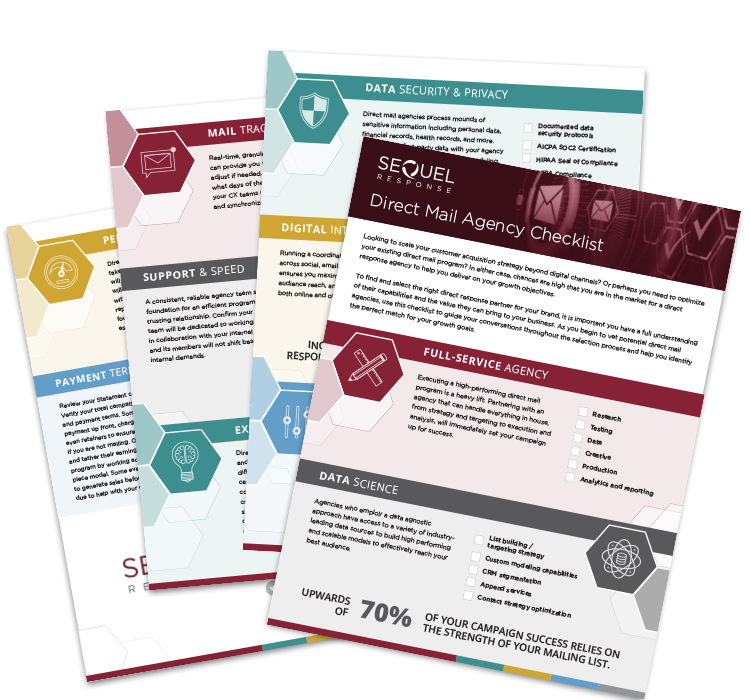Email Marketing vs. Direct Mail

One might assume that direct mail campaigns have taken a backseat to the more “modern” form of mail: email marketing. Yet, brands are continuing to use both channels to reach their top prospects and drive sustainable growth. In this comparison of email marketing vs. direct mail, we will break down each channel’s attributes to help you determine which is best suited for your marketing efforts.
|
Prefer to listen? Check out our podcast The Direct Effect: Email Marketing vs. Direct Mail |
The Case for Email Marketing
According to our 2024 Direct Mail Marketing Benchmark Report, email marketing is the second most influential form of advertisement in swaying purchase decisions. It is a digital marketing strategy that involves sending targeted emails to an audience to drive engagement, increase sales, and foster brand loyalty. With its versatile nature, it can be used for product promotions, sharing industry news, fundraising, and more.
Benefits and ROI
Email marketing is known for its high return on investment, with The Association of National Advertisers reporting that email-to-house lists have an average ROI of 44%. Access to billions of email users worldwide allows businesses to reach a vast audience, making it highly scalable for both small and large companies.
Detailed analytics allow you to track open rates, click-through rates, conversions, and more, which helps refine strategies and improve future campaigns. Emails can be highly personalized as well, leading to more relevant content for recipients and higher engagement and response rates.
Automation is another key feature. Automated campaigns like welcome emails and abandoned cart reminders help marketing teams save time and ensure consistent communication. You can even send personalized content to different segments of your audience based on behavior, preferences, and demographics.

Considerations
Email marketing offers cost efficiency and speed, but it also comes with the challenge of potential emails being ignored, deleted, or marked as spam, which reduces the likelihood of engagement. Inboxes are often crowded, making it difficult for marketing emails to stand out. Our research shows that consumers find email marketing to be the most overwhelming type of advertising. Additionally, email marketing’s reliance on technology makes it vulnerable to issues like deliverability problems and cyber threats, which are less of a concern with direct mail.
Costs and Timeline
The cost of an email marketing campaign can vary widely depending on factors such as the subscriber list size, the complexity of marketing needs, and industry-specific requirements. On average, the cost of an email marketing campaign can range from as little as $51 to over $1,000 per month for in-house campaigns. The timeline of an email campaign typically takes 4-6 weeks for planning, content creation, setup, testing, launch, and ongoing analysis and follow-up.
For those seeking a quick and affordable way to connect with prospects, email is a great option.
Best Practices for Email Marketing
- The subject line should be attention-grabbing and relevant to the recipient.
- Keep the content concise, inviting, and focused on the call to action.
- The email should be mobile-friendly and visually appealing.
- Use the recipient’s name and tailor the content to their interests.
The Case for Direct Mail
Direct mail can be a powerful tool for brands seeking to engage a large customer base or test new marketing channels outside of digital. This medium entails sending promotional materials—like postcards, letters, or hybrid self-mailers—directly to the mailboxes of your most valuable customers.
Benefits and ROI
Marketers trust targeted direct mail data due to its reliable and precise consumer insights. These data sets encompass purchase history, demographics, behavior, interests, and more, enabling precise targeting through predictive modeling to pinpoint the most responsive and potential customers. Printing advancements have enabled personalization capabilities comparable to digital channels, further modernizing this “traditional” medium.
The mail channel is also loved by marketers for its considerable response rates and remarkable return on investment. Direct mail ROI outperforms all other marketing media, reporting the highest ROI of 161% when sent to house lists. This is why marketers are eager to invest in the channel, as a thoughtfully crafted campaign can deliver excellent results.
Several studies have demonstrated that direct mail’s success is connected to its ability to subconsciously appeal to human emotions, increase brand recognition, and stimulate purchase intent. Direct mail offers vast creative potential with numerous formats, calls to action, and design strategies you can test.

Considerations
While direct mail offers a tangible and impactful way to reach customers, it is often a better fit for well-established brands with the resources to leverage its potential benefits effectively. These campaigns are significantly more expensive due to printing, postage, and handling costs. The mail channel also has a slower turnaround time as performance results need time to “cook” to ensure accuracy.
Costs and Timeline
A test direct mail campaign typically costs $75,000 to $300,000, covering expenses such as postage, paper, ink, creative design, and data. These campaigns usually take 4-8 weeks to plan, design, produce, and distribute before reaching prospect mailboxes.
If you want to offer consumers a tactile and engaging experience, direct mail might be for you.
Best Practices for Direct Mail
- Your direct mail campaign should be targeted to protect your budget and performance.
- Clearly communicate your value proposition and what you want the recipient to do.
- Include a compelling offer to prompt response.
- Use unique codes, phone numbers, or URLs to track responses.
Integrating Mail and Email for Maximum Impact
Nine out of ten marketing professionals believe that an integrated strategy positively impacts the success of marketing initiatives. To boost conversions in a “do more with less” climate, 76% of marketers are combining or intend to combine email and direct mail. These two channels are also at the forefront of current and anticipated budget hikes. This trend may be driven by their proven track record of generating higher ROI compared to other forms of advertising.
Yes, you can (and should) leverage each channel’s strengths to create a more impactful marketing mix. For instance, an initial direct mail piece could introduce a product or service, followed by a series of emails providing more detailed information and driving recipients to act. Data from both channels can be utilized to refine targeting and messaging for future campaigns, leading to more personalized and profitable marketing efforts.

—————
Both email marketing and direct mail have their place in a well-rounded marketing strategy. Email marketing excels in cost-effectiveness, reach, and measurability, making it ideal for frequent communication and engagement. On the other hand, direct mail offers tangibility, higher response rates, and less competition, which can be especially effective for making a memorable impression.
Ultimately, the choice between email marketing vs. direct mail doesn’t have to be an either/or decision. By balancing the immediacy and efficiency of email with the tactile and attention-grabbing nature of direct mail, you can create a dynamic and potent marketing campaign that resonates with your audience and drives results.
There’s never been a better time to combine two of the most beloved direct response tactics. Get in touch with SeQuel today to explore your brand’s multichannel potential.

